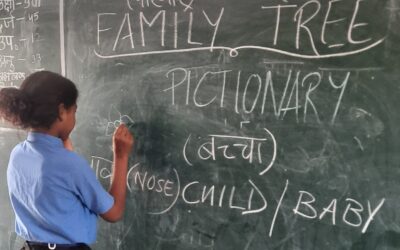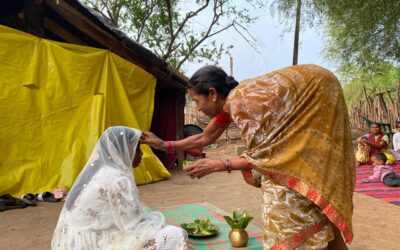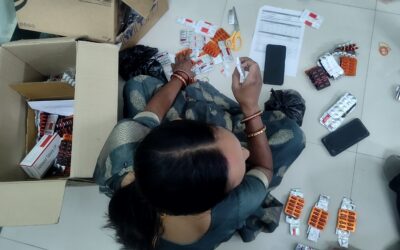Since I started working in the corporate IT industry, I’ve always been away from my home state, Andhra Pradesh. At the same time, it gave me an opportunity to explore, understand and experience other cultures. When I was working in Pune, most of my friends were from Uttar Pradesh, Rajasthan and Madhya Pradesh. While living with them, I unknowingly became fluent in Hindi and also got exposed to music from different languages and cultures.
This was also the time when I started listening to ‘Coke Studio Pakistan’ and absolutely loved every song they created. In particular, the songs in Sindhi as well as Balochi languages intrigued me, and I started listening to more Sindhi songs. I also read the legendary love stories of ‘Sassi Punnu’ and ‘Momal Rano’, a part of ‘Shah jo Risalo’, a book of poems by the legendary Sindhi poet ‘Shah Abdul Latif Bhittai’. In fact, I was so obsessed with sindhi food that I started cooking it on weekends. Other than that, I never made an attempt to learn the language or read more about the community.
Cut to now, on my first day of work at Sahjeevan, I laid my hands on a book called ‘Pastoralism in Kachchh’. Its opening page says…
“Kheermenu Makhhan Khadiyou na,
A Fakirani Jat proverb
Ghaghe ke vekiyou na,
Ne, Pakke ke chhadiyou na.
Jade he thindo, tade Kayamat achindi”
Translation: “Never separate butter from milk,
Never sell clothes the women wear
And never give up building the house with grass and straw.
Whenever this happens, know that danger is close.”
Introduction To Fakirani Jats
The first thing I noticed were the words, which sounded similar to Sindhi. After a small chat with my team, I understood that the Fakirani Jat is a pastoral community, of shepherds and herds, locally known as Maaldhari. Kutch is a prominent region for pastoralists because it is semi-arid and experiences low rainfall. That makes it suitable for herders to keep large as well as small ruminants, particularly sheep. The popular pastoral communities of Kutch are Rabaris, Sindhi Maaldharis, Bharwad, Sama, Sodha, Gadhvi and Fakirani Jats.
Fakirani Jats are concentrated around the coast of Kutch and Gulf of Khambat. They come under the sub category of ‘Kutchi Jats’. They keep Kutchi camels, Kharai camels and sometimes sheep as well. I was eager to know more about this community, their language, clothes, houses, even their ‘Maal’ or herd, and their stories. A simple search on google would tell you that they speak ‘Kutchi’, a dialect of Sindhi. The proverb above also comes from there. I was so excited to read that and started to dig deep into their story.

Kutchi Jats are pastoral nomads. They claim their descent to the ancient pastoral tribes of ‘Indus River Delta’, in present day Sindh and Balochistan provinces of Pakistan where some members of the tribe still reside. After the partition of the country, most of them lost contact with their relatives and friends in Sindh, Pakistan. The community is mainly distributed in ‘Kutch’ and ‘Saurashtra’ regions of Gujarat.
A Folk Tale
There is a popular folk tale in the community that showcases the long-standing relationship between Rabaris and Jats, the two camel-breeding Maaldhari communities of Kutch. There was once a dispute between two Rabari brothers over owning a camel. To resolve their dispute, they went to meet Savla Pir, a revered Muslim saint who created a camel out of beeswax. He then asked the brothers to choose between the two camels. The elder brother immediately picked the living camel and left. The younger one, Devidas Rabari, had no choice but to accept the wax camel.
The saint blessed Devidas, saying a camel herd will follow him on his return journey. This was on one condition that he must not look back till he reaches home. Devidas could not hold his curiosity and just before arriving home, he turned to look back. He saw a sizeable number of camels following him, but they stopped increasing because he had turned. Savla Pir had also told Devidas that whenever he finds himself with too many camels, he would have to entrust them to the care of Jats. Even today, Jat communities take care of camels assigned to them by the Rabaris.

Culture & Language
The Fakirani Jats are followers of Islam and their revered Sufi saint’s name is ‘Savla Pir’, who lived 400 years with his camel herd on an island in Kori creek, Lakhpat taluka of Kutch. Aga khan Savlani, a descendant of Savla Pir, resides in Pipar village and is the spiritual head of Fakirani Jats today.
The Kutchi language they speak is similar to the ‘Lari’ dialect of Sindhi while the Kutchi spoken in the eastern part of Kutch has a Gujarati influence. It is written in Gujarati script whereas Sindhi has its own script. The Hindu Sindhi community uses ‘Khudabadi’ script.
Even though the Jats of Kutch have their origins in Balochistan and Sindh region, I feel that their music is more similar to Sindhi music, where melodies are based on a gallop with a beat of four. On the other hand, the Balochi melodies are derived from the stroll of a camel. Hence, they all are based on a beat of six.
Architecture
The traditional houses of Fakirani Jats are called ‘Pukkas’ built with reed grass and ropes. The women play an important role in building these structured while they also take care of the newborn camels. Whenever I go to their homes, they offer tea made from Camel milk. Many of these settlements don’t have electricity or water supply. Women bring water from nearby sources.

Additionally, I always see a group of women doing embroidery while sitting under ‘Gaando bawal’ or ‘The mad plant’, the invasive ‘Prosopis Juliflora’ tree. The Fakirani Jat embroidery celebrates both geometric and abstract patterns. The motif has a mirror at the center and radiating lines inside it. To test the technical excellence in this embroidery, one needs to see if it is done densely, whether the stitches used for embroidering the mirrors are tight, if maximum area of the mirror is exposed and the base fabric underneath the embroidery does not show through.
It has been a delight to meet and know more about Fakirani Jats. The diversity in different Pastoral communities within Kutch amazes me every time I visit them.




Aga khan and aga khan savlani are two different people! I learned that today apart from your Fakirani Jats 101!